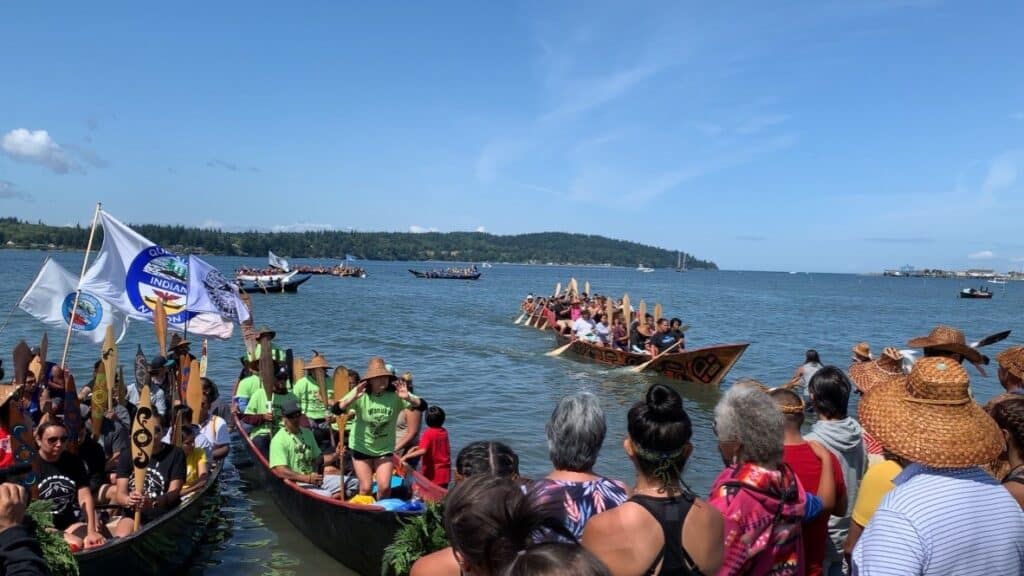by Vanessa Chin, Maritime Washington Storytelling Intern.
Image: Canoe landing at Sequim during the Paddle to Lummi, 2019. Photo by Mass Communication Specialist 2nd Class Wyatt L. Anthony, courtesy of the U.S. Navy.
For more information about the 2023 Canoe Journey, visit the official Paddle to Muckleshoot website or check out this recording of the landing at Alki.
For countless generations, canoes have connected Native peoples to their traditional ways of life. Canoes can easily move around the Salish Sea, inland waterways, and even the coast to access fishing, hunting, and gathering grounds. They also provide transportation for meeting with other Tribes, visiting family members, and conducting trade. Early white settlers to the Puget Sound area were dependent on Tribal canoes, paddlers, and guides for travel and even express mail service. Yet by the early 1900s, the introduction of roads and steamboats coupled with the pressure for Tribes to abandon their traditions nearly resulted in the extinction of the Tribal canoe. Luckily, at this same time, canoe races featuring Native American paddlers were growing in popularity. While providing entertainment for non-Native spectators, these races also gave Tribal members an opportunity to gather with other Tribes and celebrate their culture. According to former Swinomish Tribal Archivist Theresa Trebon, “Canoe racing provided a critical cultural link to the future when their traditional cultural practices would be allowed to resurface.”
This resurfacing came in the late 1980s in conjunction with Washington State’s centennial celebrations. With assistance from Tribal members across the Pacific Northwest, Emmett Oliver of the Quinault Indian Nation led an effort to celebrate Tribal canoe traditions as part of the centennial. A canoe racer in college, Emmett was a member of the Washington Centennial Commission’s Maritime Committee and urged them to support the reconstruction of Native canoes. During a 1987 meeting, he said that the project was “a vehicle for preserving Indian culture and tradition for future generations and a way to help build understanding and bridge the gap between the dominant culture and the Native culture.”

Emmett succeeded, and with support from Governor Booth Gardner, traditional carvers were commissioned to build new canoes from eight cedar logs provided by the U.S. Forest Service and National Park Service. On July 21, 1989, 40 canoes landed at Seattle’s Golden Gardens Park for the centennial ceremony, representing 17 Tribal Nations from Washington and Canada. Now known as the Paddle to Seattle, the landing was followed by several days of races and celebration. Frank Brown of the Heiltsuk Nation—who had been working to revive Native maritime traditions in British Columbia—then challenged everyone to keep the movement going by paddling canoes to Bella Bella in 1993.
Suquamish Tribal elder Marilyn Wandrey participated in the 600-mile journey to Bella Bella and was the first woman to skipper the Raven canoe for a portion of the journey. Ever since she had seen a picture of her great-grandmother sitting in a dugout canoe, Marilyn had known she wanted to be in one herself. “What made it special was I met so [much] family from other Tribes,” said Marilyn in a recent interview with Wa Na Wari. During this long journey, participants made camp at Tribal host sites along the way to rest, have a meal, and share songs and dances. “I had a much larger picture of our people because of traveling to their homes, to their villages, meeting them, and just participating in these large gatherings, listening to the testimonies of people that came, and just their telling who they are. It was just a mind/heart-changing event,” Marilyn recounts.
After Bella Bella, Marilyn officially became the skipper of the Raven canoe and helped organize a journey around the Key Peninsula in Puget Sound. This circuit, called the Full Circle Journey, was completed in two parts from 1995 to 1996. “That gave us an opportunity to put kids in the water, to put children on a canoe, to understand and know what that kind of experience was,” said Puyallup Tribal elder Connie McCloud about the Puyallup Tribe‘s participation in the journey.
From adolescents to elders, all ages are invited to “pull” (the preferred term for paddle) during a Canoe Journey. Marilyn’s granddaughter and Suquamish Museum Collections Management Specialist Angee Harrington pulled for the first time when she was 12 during the Full Circle Journey in 1996. In 2017, Marilyn passed on her role as skipper to Angee. Since then, Angee has been the captain of the Raven canoe family, which is comprised of 40 members and includes the canoe pullers, support boat team, and ground support team. There can be multiple canoe families within a Tribe, and sometimes canoe families are not associated with a Tribe, like the University of Washington’s Canoe Family, which has been learning how to carve cedar canoe paddles for this year’s journey under the guidance of Philip H. Red Eagle.

Since the Full Circle Journey, Tribal Canoe Journeys have become more frequent, with a different Tribal Nation hosting each year. According to the Squaxin Island Tribe, today an estimated 12,000 people and more than 100 canoes from up to 90 U.S. Tribes, Canadian First Nations, and New Zealand participate in the annual journeys. Many who have participated as skippers, pullers, support crew, or hosts have noted the journey’s capacity to foster healing and personal growth. “I’ve seen people where they were alcoholics go sober. Just good things have happened as a result of being a part of a Canoe Journey. I really believe that that water, and being out there in the elements, is very healing,” says Marilyn. For Angee, being a puller and skipper has taught her to have patience with others and to work through conflict.
It is common for participants to draw strength from the hardships they encounter during the journey, yet the positive experiences of teamwork and connections to Tribal traditions can be just as powerful, especially for youth. “When youth are exposed to such experiences, they are less likely to gravitate toward substance use, and it gives them the skills to make better choices into adulthood,” says Lisa Jackson, the Training and Curriculum Manager for Healing of the Canoe, a collaborative project that uses the metaphor of Canoe Journeys to engage with Tribal youth about problem-solving and substance use. “By asking youth what obstacles they could encounter on a Canoe Journey, then asking them how they would solve those problems, it paves the way for asking about obstacles in everyday life and how they might solve them.”
This year, the Muckleshoot Tribe will be hosting the first Canoe Journey since 2019, as the last few journeys have been canceled due to the pandemic. The theme for Paddle to Muckleshoot is “Honoring Our Warriors Past and Present.” The public is invited to Seattle’s Alki Point on July 30 to witness the reception of more than 100 canoes by Muckleshoot Tribal members, just as their ancestors had welcomed visitors to their shores since time immemorial.
If you would like to learn more about Tribal Canoe Journeys, we invite you to explore the following resources:
- Lushootseed Phrases to Use on Canoe Journey (Puyallup Tribe)
- Makah Protocol at Squaxin Island Hosting, 2012 (Squaxin Tribe YouTube)
- Tulalip News: Canoe Journey Articles
- Canoes – Pulling Together: A Documentary Film – by James M. Fortier (Presented by the Muckleshoot Tribe, Whatcom County Library System YouTube)
- 2018 Power Paddle to Puyallup (Native Daily Network YouTube)
- Canoe Journey – Paddle to Lummi 2019 (Children of the Setting Sun YouTube)
- Canoe Way Documentary (Cedar Media YouTube)
- Canoe Journey 2017: Catching Songs from Suquamish – Project 562 (YouTube)
- Canoe Journey: Following Traditional Protocol – Project 562 (YouTube)
- Tribal Journeys Handbook – by American Friends Service Committee
- Canoe Journey 2006 – Paddle to Muckleshoot – by American Friends Service Committee
- Tribal Canoe Journey and Science Connect in Salish Sea (Earthfix Media YouTube)
- All Nations Paddles Up – Resources for Canoe Journey Hosts and Participants
- Footage from Bella Bella 1993 Journey (YouTube)

